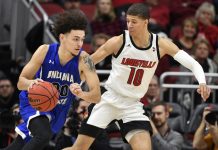SAN ANTONIO (AP) As the NCAA deals with corruption in college basketball and faces questions about sexual assault scandals on campus, the association is finally moving toward reform on far less somber subject that has been every bit as vexing: transfer rules.
”How complicated could this be?” NCAA President Mark Emmert said at the Final Four in San Antonio. ”It’s about students changing schools. And yet I’ve never seen anything that’s quite as intractable a problem as this one because you just can’t get agreement.”
After years of NCAA committees and task forces talking about reforming transfer rules, change is on the horizon. The latest working group expects to have a proposal for NCAA leadership to consider by late April, so real reform could be in place by next school year. The result is likely to limit the power schools and coaches have over if and where a player can transfer, and maybe even eliminate the required redshirt year for some transfers – but not all.
In men’s college basketball, the number of Division I players who transfer from one four-year school to another has risen from 10 percent in 2010 to about 13 percent in 2016, according to the NCAA. Only soccer had a higher percentage of its athletes transferring between four-year schools among men’s sports. At the Final Four this weekend, each team will start at least one player who transferred in. Including players sitting out to comply with NCAA rules, Villanova (one), Kansas (two), Loyola-Chicago (three) and Michigan (three) have a combined nine transfers on their rosters.
Michigan’s three transfers have all taken different paths to Ann Arbor.
Charles Matthews started his college career at Kentucky, one of many star recruits in John Calipari’s program. After playing sparingly as a freshman, he decided to transfer and landed at Michigan, where he had to sit out his sophomore season to satisfy NCAA rules. It’s a called a year in residence.
”It’s not fair, but it is what it is,” Matthews said.
Duncan Robinson came to Michigan after playing his freshman season at Division III Williams College.
”It was huge for me,” Robinson said about sitting out a season. ”I definitely wouldn’t have been able to be impactful if I had played right away. Or as impactful. In terms of if it’s fair, that’s a whole different conversation. Obviously, there’s some contradictions in the world of college basketball. You could go on for hours. But I’m not going to be changing them any time soon.”
Not all NCAA athletes are required to do a so-called year in residence. In many sports, there is a one-time exception that allows athletes to transfer from one school to another without sitting out.
The transfer working group is considering the question of whether to make transfer rules uniform across all sports. That could mean making transfers more restrictive for some athletes. One of the concepts being considered is attaching an academic benchmark to the year in residence that would allow athletes with grade-point averages of 3.0 or better to transfer without sitting out. There was also some discussion about allowing players to transfer after a school has a coaching change.
Jaaron Simmons went to Houston out of high school and came off the bench as a freshman. But after the head coach James Dickey and the staff that recruited him was let go, he transferred to Ohio University in the Mid-American Conference. Simmons sat out one season and played two as one of the Bobcats’ top players. After graduating from Ohio in 2017 with a year of eligibility remaining, he transferred to Michigan. NCAA rules allow athletes who have graduated to transfer without sitting out.
The graduate transfer rule has been a point of contention among many coaches, especially those at mid-major schools who fear losing key players to higher-profile programs in more prominent conferences – the way Ohio did with Simmons. Creating more opportunities for players to transfer without having to sit out could be devastating to mid-major programs, Loyola coach Porter Moser said.
”Can you imagine the Missouri Valley, people look at that league, how good of a league it is, it’s just going to be a farm system and they’re going to pick. Where does it end?” said Moser, who starts transfers Clayton Custer (Iowa State) and Marques Townes (Fairleigh Dickinson).
Malik Newman, the star of Kansas’ regional final victory against Duke, transferred to the Jayhawks from Mississippi State. He said sitting out a season after his transfer was beneficial, allowing him to work on his game, learn coach Bill Self’s system and get healthy.
”Besides game day, everything else was good,” Newman said.
Villanova’s Eric Paschall left Fordham from the Atlantic-10 after a coaching change.
”The school was supportive,” Paschall said. ”I know it gets difficult with releases and all that, but if you feel like you should transfer then you should.”
While nothing is a done deal, one aspect of the transfer rules almost certain to change is athletes will no longer have to ask for permission to be released from a scholarship. Coaches currently can deny that release or grant it with restrictions on where a player can go. While the vast majority of transfers go off smoothly, the permission component can get contentious. And in almost every case, schools and coaches come out looking like villains for trying to dictate where a student can attend school.
South Dakota State athletic director Justin Sell leads the current transfer working group, comprised of administrators, coaches and student-athletes. He said the group is scheduled to meet once more in mid-April to finalize a wide-ranging proposal for conferences to consider at spring meetings in May. And hopefully, before everybody goes on summer vacation in July, the NCAA will finally have new transfer rules.
One thing is for sure: No matter where this ends, it will leave many unsatisfied.
”Can we build consensus around 75 or 80 percent of it and really make a positive difference moving forward,” Sell said. ”That’s the big piece for us. Not worrying so much about do you get it right for every single person that’s out there and every situation? I don’t think that’s very realistic.”
—
Follow Ralph D. Russo at www.Twitter.com/ralphDrussoAP
—
More AP college basketball: https://collegebasketball.ap.org ; college football: https://collegefootball.ap.org ; https://twitter.com/AP-Top25 and https://www.podcastone.com/ap-sports-special-events
25% Bonus via Western Union

















